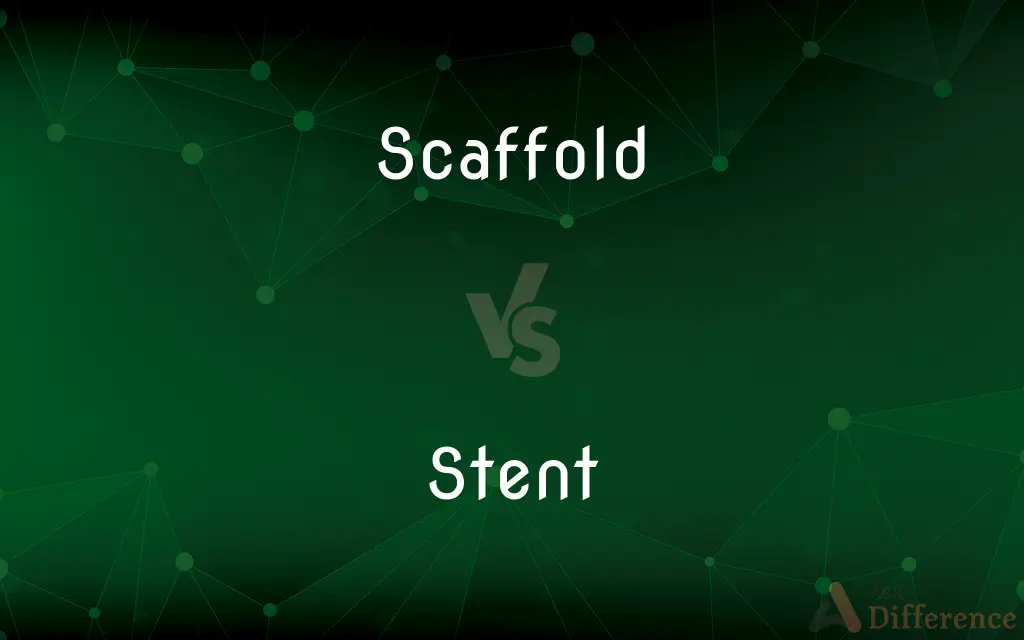Scaffold vs. Stent — What's the Difference?
Edited by Tayyaba Rehman — By Fiza Rafique — Updated on April 1, 2024
A scaffold provides temporary support for construction, while a stent permanently opens body passages.

Difference Between Scaffold and Stent
Table of Contents
ADVERTISEMENT
Key Differences
Scaffolds are temporary structures used on construction sites to support workers and materials, enabling the safe erection, repair, or maintenance of buildings and structures. On the other hand, stents are medical devices implanted in the human body to keep passageways, such as arteries or ducts, open, ensuring the normal flow of bodily fluids.
While scaffolds are made from materials like metal, wood, or bamboo, depending on the project's requirements and are designed to be dismantled after use, stents are manufactured from metal or polymer and are intended to remain in the body permanently or until they biodegrade, if they are made from biodegradable materials.
The application of scaffolds is primarily in the field of construction and architectural restoration, facilitating access to high and hard-to-reach areas. Conversely, stents are used in medical procedures, such as angioplasty, to treat conditions like coronary artery disease by keeping arteries open and improving blood flow.
Scaffolding systems are chosen based on factors like the height and complexity of the construction project, worker safety, and the project duration. In contrast, the choice of stent type (metallic, drug-eluting, or biodegradable) depends on the medical condition being treated, the patient's health status, and the specific body passage needing support.
Both scaffolds and stents share the concept of providing support, but their contexts of use construction versus medical highlight their fundamental differences in purpose, material composition, and permanence.
ADVERTISEMENT
Comparison Chart
Definition
A temporary structure for support and access during construction projects.
A medical device implanted to keep passageways open.
Material
Made from metal, wood, or bamboo.
Typically made from metal or polymer.
Purpose
To support workers and materials in construction.
To ensure the normal flow of bodily fluids by keeping passages open.
Permanence
Temporary and dismantled after use.
Permanent or biodegradable in the body.
Field of Use
Construction and architectural restoration.
Medical procedures, such as angioplasty.
Compare with Definitions
Scaffold
A temporary structure used in construction to support workers and materials.
The workers used a scaffold to reach the upper levels of the building.
Stent
A device implanted in the body to keep passages open.
The doctor recommended placing a stent to improve blood flow in the blocked artery.
Scaffold
Often made of metal, wood, or bamboo, depending on the project.
The construction of the bamboo scaffold was crucial for the restoration of the ancient temple.
Stent
Used to treat various medical conditions by supporting bodily passageways.
To treat the patient's condition, a stent was placed in the ureter to prevent obstruction.
Scaffold
Facilitates safe access and support during construction or repair projects.
Erecting a scaffold around the monument allowed for safe masonry work.
Stent
Can be designed for permanent placement or to biodegrade over time.
The permanent metal stent will remain in the body to ensure the artery stays open.
Scaffold
Designed to be dismantled and removed once the project is completed.
After the completion of the painting job, the scaffold was carefully dismantled.
Stent
Made from durable materials like metal or biodegradable polymers.
The biodegradable stent gradually dissolves, leaving the artery open and free from foreign material.
Scaffold
Primarily seen in construction sites for buildings, bridges, and historical restorations.
The elaborate scaffold system enabled workers to access all parts of the bridge for renovation.
Stent
Employed in medical procedures like angioplasty or to support ducts and vessels.
During the angioplasty procedure, a drug-eluting stent was used to prevent the artery from narrowing again.
Scaffold
A temporary platform, either supported from below or suspended from above, on which workers sit or stand when performing tasks at heights above the ground.
Stent
In medicine, a stent is a metal or plastic tube inserted into the lumen of an anatomic vessel or duct to keep the passageway open, and stenting is the placement of a stent. There is a wide variety of stents used for different purposes, from expandable coronary, vascular and biliary stents, to simple plastic stents used to allow the flow of urine between kidney and bladder.
Scaffold
A raised wooden framework or platform.
Stent
A substance used in dentistry for taking impressions of the teeth.
Scaffold
A platform used in the execution of condemned prisoners, as by hanging or beheading.
Stent
An assessment of property made for purposes of taxation
It was recorded in the stent book
Scaffold
To provide or support with a raised framework or platform.
Stent
Assess and charge (a person or a community) for purposes of taxation
Stent the Parish of Kildaltan in the ascertained sum
Scaffold
To place on a raised framework or platform.
Stent
A device used to support a bodily orifice or cavity during skin grafting or to immobilize a skin graft following placement.
Scaffold
A structure made of scaffolding for workers to stand on while working on a building.
Stent
A short tubular device made of wire mesh or fabric that is placed permanently in an anatomical passage, usually an artery during angioplasty, to keep it open after occlusion.
Scaffold
An elevated platform on which a criminal is executed. Category:en:Capital punishment
Stent
(archaic) An allotted portion; a stint.
Scaffold
An elevated platform on which dead bodies are ritually disposed of, as by some Native American tribes.
Stent
(archaic) To keep within limits; to restrain; to cause to stop, or cease; to stint.
Scaffold
(metalworking) An accumulation of adherent, partly fused material forming a shelf or dome-shaped obstruction above the tuyeres in a blast furnace.
Stent
(archaic) To stint; to stop; to cease.
Scaffold
(sciences) A structure that provides support for some other material.
Stent
To keep within limits; to restrain; to cause to stop, or cease; to stint.
Then would he weep, he might not be stent.
Yet n'ould she stentHer bitter railing and foul revilement.
Scaffold
(transitive) To set up a scaffolding; to surround a building with scaffolding.
Stent
To stint; to stop; to cease.
And of this cry they would never stenten.
Scaffold
(transitive) To sustain; to provide support for.
Stent
An allotted portion; a stint.
Scaffold
(transitive) To dispose of the bodies of the dead on a scaffold or raised platform, as by some Native American tribes.
Scaffold
A temporary structure of timber, boards, etc., for various purposes, as for supporting workmen and materials in building, for exhibiting a spectacle upon, for holding the spectators at a show, etc.
Pardon, gentles all,The flat, unraised spirits that have daredOn this unworthy scaffold to bring forthSo great an object.
Scaffold
Specifically, a stage or elevated platform for the execution of a criminal; as, to die on the scaffold.
That a scaffold of execution should grow a scaffold of coronation.
Scaffold
An accumulation of adherent, partly fused material forming a shelf, or dome-shaped obstruction, above the tuyères in a blast furnace.
Scaffold
To furnish or uphold with a scaffold.
Scaffold
A platform from which criminals are executed (hanged or beheaded)
Scaffold
A temporary arrangement erected around a building for convenience of workers
Scaffold
Provide with a scaffold for support;
Scaffold the building before painting it
Common Curiosities
Can a scaffold be permanent?
No, scaffolds are designed to be temporary and are dismantled after their purpose is served.
What is a scaffold?
A temporary structure used to support workers and materials during construction or repair projects.
How do scaffolds and stents differ in material?
Scaffolds are made from materials like metal, wood, or bamboo, while stents are usually made from metal or polymers.
Are stents used outside of medical contexts?
No, stents are specifically designed for medical applications to support bodily passageways.
What is a stent?
A medical device implanted in the body to keep passageways open and ensure the normal flow of fluids.
How do scaffolds support construction work?
They provide a platform for workers to safely access high or hard-to-reach areas during construction or restoration.
What conditions can be treated with stents?
Stents are used to treat various conditions, such as blocked arteries, by keeping the passageways open.
How does the permanence of scaffolds and stents reflect their purposes?
Scaffolds' temporary nature reflects their support role in construction, whereas stents' permanence or biodegradability caters to long-term medical support.
Can anyone erect a scaffold?
Erecting a scaffold typically requires trained professionals to ensure safety and compliance with regulations.
Is the use of scaffolds limited to construction?
While primarily used in construction, scaffolds can also be used in restoration and painting projects.
How is the choice between different types of stents made?
The choice depends on the medical condition, the specific needs of the patient, and the advice of healthcare professionals.
How are stents placed in the body?
Stents are placed through a minimally invasive procedure, often involving catheterization of the affected artery or passageway.
Can the material of a scaffold affect its use?
Yes, the material impacts the scaffold's durability, weight, and suitability for different environmental conditions.
What advancements have been made in stent technology?
Innovations include drug-eluting stents that release medication to prevent artery re-narrowing and biodegradable stents.
Why are biodegradable stents used?
They offer a temporary support solution that dissolves after the passageway has healed, reducing the risk of long-term complications.
Share Your Discovery

Previous Comparison
Disrobe vs. Unrobe
Next Comparison
Afraid vs. PetrifiedAuthor Spotlight
Written by
Fiza RafiqueFiza Rafique is a skilled content writer at AskDifference.com, where she meticulously refines and enhances written pieces. Drawing from her vast editorial expertise, Fiza ensures clarity, accuracy, and precision in every article. Passionate about language, she continually seeks to elevate the quality of content for readers worldwide.
Edited by
Tayyaba RehmanTayyaba Rehman is a distinguished writer, currently serving as a primary contributor to askdifference.com. As a researcher in semantics and etymology, Tayyaba's passion for the complexity of languages and their distinctions has found a perfect home on the platform. Tayyaba delves into the intricacies of language, distinguishing between commonly confused words and phrases, thereby providing clarity for readers worldwide.
















































